DRAFT RESOLUTION
United Nations Human Rights Council
Topic: Children’s human rights in Syria
Sponsors: The U.S.A., FRANCE, RUSSIAN FEDERATION, THE UK, THE P.R.C., MEXICO, PHILIPPINES, UAE
Signatories: Pakistan, Germany, Namibia, Kenya, Saudi Arabia, Viet Nam, Republic of Korea, Argentina, Czech,Cuba, India, Ireland
United Nations Human Rights Council
civilians and children;
’s security. government;
’s’ security and education;
Syria and Insurgency;
PART I: THE PROTOCOL TO PROTECT CHILDREN:
1. Formulate following terms to protect children’s rights:
(a) Children should not used as children soldiers. some children in Syria are used as soldier without knowing the terrible surroundings. They also were under sexual violence; the soldiers in the government tortured children.
(b) Children need rights to defend themselves.
(c) Children have the rights to go to school and to be educated.
PART II: THE GUARANTEE OF EDUCATION:
1. Sets up an independent temporary organization to manage the education department;
2. Suggests the United Nations to set up temporary school that surrounded the Syria for Syrian children who had got involved in the war;
3. Demands all United Nations’ members to send certain percentage of teachers and volunteers to support the school;
4. Provides basic facilities to guarantee, especially children, the quality of academic teaching;
5. Refreshes children’s conception of wars;
6. Builds up an adequate perspective of wars as well;
7. Requires all United Nations’ members provide certain percentage of soldiers to protect the security of the school that established by United Nations;
PART III: THE SET-UP OF SECURITY COUNCIL ARMY AND ITS ACTIONS:
1. Calls on the UNSC to permit the forces to protect the security of non-conflicts zone;
2. Recommends the forces to equip highly promoted armor and weapons in order to keep:
(a) The security of the refugee camps and the surrounding environments;
(b) Other civilians and children who cannot reach the refugee camp;
3. Claims the royalty and well-developed ideology of the forces;
4. Urges member states to cooperate with the resolution made by the UNSC, and execute immediately;
5. Recommends the UNSC to take charge of the financial support for the military operation;
PART IV: THE RESOLUTION FOR CHILDREN SOLDIERS:
1. Condemns parties who recruited children as soldiers;
2. Urges both sides of the conflict(Government of Syria and Insurgency)
to execute a ceasefire and negotiate peacefully;
3. Calls on International Society to give financial support to Syria to
help:
(a)Recover the domestic education system;
(b)Help children and the civilization get back to normal life in order to keep them from being recruited into the army;
4. Recommends giving out relevant manuals with contents of damage brought by the war;
PART V: THE PHYSICAL TREATMENT:
1. Recommends sending medical corps to help save the children who are injured in the war;
2. Calls on the WHO and other organizations to send medicine to Syria in order to prevent people from being infected by epidemics;
3. Requests establishing a commission to supervise the usage of medical aids;
4. Urges forming a medical subside council;
5. Calls on UNICEF to send both psychologists and financial aids to
Syria and help the children get out of the shadow brought by the war;
Part VI: THE RESPONSIBILITIES OF GLOBAL ORGANIZATIONS:
1. Calls on extend the current power of Independent International Commission of Inquiry to assess crime actions targeting children;
2. Calls on establishing special International court to investigate violations and abuses committed against children according to the previous commission and demands all parties comply with their obligations under the International Laws.
3. Calls on the non-governmental organizations to cooperate under the resolution of HRC and give all kinds of supports.
4. Calls on the neighbor states to open their border in a planned way and let the children to pass the border into safer areas without complicated procedures.
第二篇:模拟联合国英文会议手册
SDUW—MUN 2010.10
DIRECTORY
Welcome Letter Page 2 Part 1 The Schedule of SDUWMUN Page 3 Part 2 The Committee Introduction Page 5
1.The Committee History
2.The Structure of the Committee
3.Country Matrix
Part 3 The Topics & Background Page 6 Part 4 The Advice of theDais & Relevant Websites Page 7 Part 5 Conference Procedure & Rules Page 8
1. General Conference Information
2. Rules on Formal Debate
3. Rules Governing Resolutions
4. Rules Governing Voting
5. Precedence of Motions
Part 6 Award Page22 Part 7 Meeting Etiquette Page23 Appendix I Page24
SICA - 1 -
SDUW—MUN 2010.10
Dear Delegates and Faculty Advisors,
It’s my distinct pleasure to welcome you to the fourth session of Model United Nations of Shandong University at Weihai. This conference will be held from 30th October to 31st October, 2010, hosted by the International Cooperation and
Communication Department, organized by Students’ International Communication Association. We also have invited some universities in Shandong Province to participate in the conference.
This is really an amazing conference, which not just develops your expertise in research, writing, public speaking but also the art of negotiation as you fight for the interests of the countries you will represent on every conceivable topic relevant in today’s global community. I sincerely hope that your experience at SDUWMUN will empower you to further your passion for international diplomacy.
This April, the third session of SDUWMUN was held successfully. This October, SDUWMUN will continue the mission to present an exciting conference. Recently, the most heated discussed topics are financial crisis and human rights, so this time, our topic is that ‘the Background of the Impact of Global Financial Crisis on the Universal Realization and Effective Enjoyment of Human Rights’, we will provide a comprehensive study guide to help you become well-versed with the topic of
debate. Furthermore, we hope that you can be able to benefit through taking part in the preparation.
All of us are very excited to welcome you to Model United Nations in Shandong University at Weihai. SDUWMUN can be considered as a competition, a forum, and also a big brilliant party. We thank you for all of your hard work in preparing for this conference and are looking forward to an incredible party. Let’s enjoy it! And never hesitate to contact us with any questions you may have.
Yours sincerely,
石玉丹(Secretary-General)
Shandong University at Weihai Model United Nations
- 2 - SICA
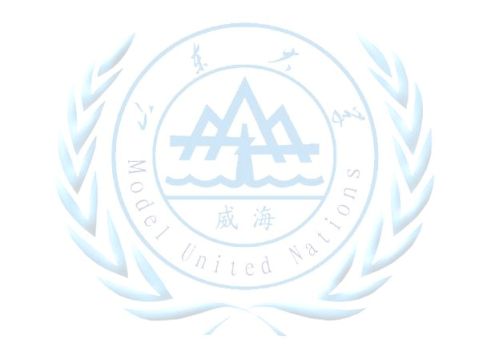
SDUW—MUN 2010.10
SICA - 3 -
SDUW—MUN 2010.10
?PROCESS:
Date&Time 10.10 (19.00-21.00)
10.17 (19.00-21.00)
10.22 (19.00-21.00)
10.24
Event Conference Training(one) Conference Training(two) Conference Training (three)
Hand in the Position Paper
10.29
Send the of Position Paper to
before 12 o’clock
The Invited Members Arrive, Welcome Dinner
Accommodation:Wenhua
Hotel at SDUW
Place Wenhua Hotel
Rehearsal Note Training of the procedure Training of the topics
10.30(Sat) 8.00-9.00 10.30 (Sat) 9.00-9.30
Opening Ceremony Group Photograph
- 4 -
SICA
SDUW—MUN 2010.10
10.30 (Sat) 9.30-12.00 10.30 (Sat) 14.00-17.30
Formal Conference (One) Formal Conference (Two)
Submit the electronic version of Draft Resolutions to before 18.30
10.30 (Sat) 19.00-20.30
Young diplomat dance
10.31(Sun) 8.00-12.00
Formal Conference (Third)
The Reporting Hall
at
After discussing the
draft resolution adjourn 40 minutes,before the end of the time, submit the electronic version of the amendments to the secretariat
Internet Building
10.31(Sun) 14.00-15.00 10.31 (Sun) 14.00-15.00
News Conference Award Ceremony Closing Ceremony
SICA
- 5 -
SDUW—MUN 2010.10
Committee History
The Human Rights Council is an inter-governmental body within the UN system made up of 47 States responsible for strengthening the promotion and protection of human rights around the globe. The Council was created by the UN General Assembly on 15 March 2006 with the main purpose of addressing situations of human rights violations and make recommendations on them.
One year after holding its first meeting, on 18 June 2007, the Council adopted its “Institution-building package” [Word file] providing elements to guide it in its future work. Among the elements is the new Universal Periodic Review mechanism which will assess the human rights situations in all 192 UN Member States. Other features include a new Advisory Committee which serves as the Council’s “think tank” providing it with expertise and advice on thematic human rights issues and the revised Complaints Procedure mechanism which allows individuals and organizations to bring complaints about human rights violations to the attention of the Council. The Human Rights Council also continues to work closely with the UN Special Procedures established by the former Commission on Human Rights and assumed by the Council.
The Structure of the Committee
The Dais:
A Chair
Two Rapporteurs
The secretariat:
One Secretary
One Deputy Secretary General
Three Secretary Assistants
- 6 - SICA
SDUW—MUN 2010.10
Country Matrix
Angola Iran
Argentina Israel
Bahrain Japan
Brazil Korea
China Nigeria
Cuba Philippines
Ecuador Russia
France United Kingdom
Germany United States of America
India Zambia
The Topics:
The Background of The Impact of Global Financial Crisis on the Universal Realization and Effective Enjoyment of Human Rights
The Background:
In August 2007, the international financial crisis erupted, causing the decrease of trade, increase of unemployment and the deduction of investment. In the situation of the poor economy, our first concern is the recovery of the economy, but as the crisis spread, the other impacts of the crisis have been shown, and its influence to the human rights has been noticed.
On Feb. 20th 2009, UN Human Rights Council held a special conference on the influence on the global economic and financial crisis. This meeting was supported by most countries of the UN Human Rights Council, and was the brainchild of Egypt with the support of the African Union and Brazil. The president of the Human Rights Council said during meeting that the crisis posed a grave threat for human rights. He further emphasized that ensuring the basic human rights was the fundamental way to respond to the global crisis.
In June 2009, United Nations held the Conference on the World Financial and Economic Crisis and its Impact on Development in New York City. The United Nations convened a three-day summit of world leaders from June 24th to June 26th at its headquarters in
SICA - 7 -
SDUW—MUN 2010.10
New York City to assess the damage from the global economic crisis. The conference concluded that people in developing countries were suffering disproportionately due to the crisis and it is the responsibility of the developed countries that caused the crisis to help. They recommended that developed countries follow the Monterrey Consensus' recommendation by giving 0.7% of their GDP as aid to poor countries.
NGOs also closely followed this issue. After the global financial crisis began, six major NGOs made a joint statement that the crisis not only hurt business but also infringed upon human rights. Presently, basic social rights such as the right to shelter, healthcare and education are bearing the brunt of pressure. As the economic crisis worsened, governments also increased censorship to stifle potential unrest. NGOs are putting more pressure on governments to respect human rights by various ways.
I. Which kind of country is influenced most by the financial crisis
and the reasons;
II. What challenges of human rights protection are we faced with
under the pressure of the financial crisis;
III. How do we do with these challenges.
United Nations
UNA-China
Muners
The Database of UN Human Rights Treaty
The UN Division for the Advancement of Women
- 8 - SICA
SDUW—MUN 2010.10
1. General Conference Information
I. THE PROCESS: COMMITTEE SESSIONS
Formal Debate
The formal debate will begin with an open Speakers’ List, during which time representatives have the opportunity to share their views with the entire committee. The time limit for each delegate is 2 minutes. In formal debate, representatives may make speeches, answer questions, and introduce and debate draft resolutions and amendments. Points and motions are in order during formal debate.
Unmoderated Consultation
While in formal debate, representatives may move for an unmoderated consultation for a fixed period of time, 5 minutes in average. The consultation serves as a temporary suspension of formal debate. During this time, representatives can meet informally with each other and the committee staff to discuss working papers, draft resolutions, amendments, and other relevant issues. to use consultation time to the best of their advantage.
Moderated Consultation
Representatives can also make motions for Chairperson shall call upon representatives to address committee members for a predetermined amount of time which should be decided by the delegate who make this motion. No motions are in order during a moderated discussion. Submission and Debate of Proposals
The process for producing a resolution in a CNMUN committee consists of two written stages: the working
SICA - 9 -
SDUW—MUN 2010.10
paper and the draft resolution. By writing, submitting, introducing and debating on proposals, the committee will be propelled towards a pragmatic and holistic solution to the issue. The path towards a resolution will be depicted in details below.
Voting
The final act in the discussion of a topic area is voting on the draft resolution(s) on the floor (as amended throughout the course of debate). A of the topic area is normally over when one comprehensive resolution has been passed. And then the meeting will be adjourned if a simple majority members present and voting.
II. THE PATH TOWARDS A RESOLUTION
If we are to understand the nuances of the debate, we must first grasp the path towards the resolution.
1). Working Paper
Working papers mainly serve as a point of reference for discussion in committee by putting abstract ideas into a concrete, written form (please see the sample provided later in this guide). the Chairperson, working papers are copied and distributed so that the committee’s representatives can learn about the positions and interests of other representatives. As the committee’s work progresses, new points and ideas should be compiled into new working papers. Amendments cannot be made to working papers. Subsequent working papers must contain ideas that do not appear on any previous or concurrent working papers. Working papers Representatives should be aware that working papers are not “mini-resolutions” in that they do not need to be in any specific format and do not need to cover all the issues raised in the Questions a Resolution Must Answer portion of the study guide. Additionally, ideas do not have to appear in working papers before they can become draft resolutions. In another word, working papers do provide a very useful tool for getting the entire committee’s feedback on specific ideas before presenting them as formal draft resolutions.
- 10 - SICA
SDUW—MUN 2010.10
2).Position Paper
Position papers are single-spaced, one-page documents that explain your
country’s position on a particular topic. They should be instructive, clear, and concise, so as to leave no doubt on your country’s stance. Include your name, the name of your university, and the country delegation you are representing at the top of the document. Each delegation of a committee must turn in one position paper before the conference. Please adhere to the following three-paragraph format, setting the topic of Children’s Education Rights as an example:
The first paragraph must state your country’s position on this topic. What is
your country’s education status of children? What are the obstacles of your nation to achieve the goal of “Universal primary education” and “Gender equality in education”?
The second paragraph will present what kinds of efforts your country has
paid on attempt to settle down this issue. In addition, what is the relationship between your country and the international community in cooperation? What specific policy steps at the international, regional, national and community levels does your country desire to undertake in order to promote the domestic educations situation for children?
The final paragraph must present a plan to ensure and expand the availability
of primary education enrollment in impoverished nations and regions, especially in SAS and SSA. Considering the proposed solutions presented in the topic booklet, these plans must be viable and involve specific roles for United Nations agencies, national governments, regional organizations, international bodies, and NGOs in their implementation. A strong plan will address most of the QARMAs. Ingenuity (i.e. not simply copying the suggestions already presented) and novel syntheses of existing proposals are strongly encouraged. Country:
Committee:
Topic:
Delegates:
3). Draft Resolutions
As in the real United Nations, the main vehicle of action at CNMUN is the
resolution, a formal document in which a committee spells out the action to be taken in order to solve a particular problem. Each draft resolution should deal
specifically with the topic area currently under discussion by the committee. The following criteria must
SICA - 11 -
SDUW—MUN 2010.10
be met before a draft resolution can be introduced to the committee:
* It must completely address the points set out in the “Questions a Resolution Must Answer” section of the study guide as well as any other points that have been raised in the course of debate.
* It must be well-written, concise, comprehensive, and free of grammatical and typographical errors.
* It must have the minimum number of signatories as stipulated in the Rules of Procedure.
* It must receive the approval and signature of the Chairperson.
* It must be completely original work done at the conference; no prewritten draft resolutions will be allowed, and plagiarism will not be tolerated.
Because the committee can pass only one resolution on each topic, representatives should expect to be asked to revise draft resolutions several times before they meet the Chairperson’s standards. While the Chairperson will not advocate a particular solution, it is his or her responsibility to ensure that the committee has fulfilled its responsibilities and adequately addressed the entire topic before it can be introduced as a draft resolution. The Chairpersons are trained to be very discriminating in accepting draft resolutions, and representatives should not be surprised or offended if the dais staff sends a proposal for a draft resolution back to the committee for revision before approving it. It is the committee’s responsibility to construct an effective resolution to handle the situation at hand. When a draft resolution is introduced, it is usually not ready for an immediate vote. Much debate, compromise, and revision are involved in the formulation of a resolution that can be agreed upon by the committee. Listed below are some (not comprehensive) guidelines for good resolutions:
* A good resolution should represent a technical solution to the issue. It is not enough to merely create an additional committee to discuss the problem or to condemn or approve of this or that country. The resolution should present specific, concrete proposals to deal with the issue at hand.
* The resolution should be the product of a workable compromise among the nations party to a dispute (in an antagonistic political situation) or among the competing viewpoints on how an issue should be resolved (in a cooperative problem-solving situation). This means all involved parties should agree. Any resolution dealing the situation in Israel/Palestine, for example, is meaningless if it does not meet with the approval of both Israel and the Arab community. * The compromise reached must take into account the relative power of the parties to the dispute. In the United Nations, each nation has one equal vote. But in the international community, it is a fact that some nations have more power than others. When drafting a resolution, keep in mind that a realistic world view is essential to a solution that can be effectively implemented in the global arena.
- 12 - SICA
SDUW—MUN 2010.10
Committee:
Topic:
Sponsors:
Signatories:
4). Amendments
The amendment process is used to perfect and improve draft resolutions as the course of debate evolves to reflect concerns that may not have been addressed in the original document. A clear understanding of the rules of procedure is very important to the process of proposing, debating, and voting on an amendment. Chairperson will clarify this process at conference, time permitting, but a review of the amendment process as described in the Rules of Procedure is highly recommended to optimize a committee’s efficiency and Only at the Chairperson’s discretion can amendments be made without vote (on non-substantive matters such as typos). There are no friendly amendments, and regardless of the effect they have on the draft resolution in question. If an amendment is passed by the body, it is immediately incorporated into the text of the draft resolution for the purposes of debate and voting.
Amendment
Committee::
Topic::
Sponsors:
Signatories:
2. Rules on Formal Debate
During the formal debate, all delegates are required to follow the rule of procedures and maintain decorum. Formal debate can be divided into the following segments:
SICA - 13 -
SDUW—MUN 2010.10
Roll Call
In this phase, the Rapporteur would announce the name of each member state and observer in alphabetical order. Upon announcement, the aforementioned country’s delegate would raise his/her placard and announce “present”.
Setting of Agenda
Establishment of Speakers List
The Committee will have an open Speakers List for the topic area being discussed. The Director would initially call for countries willing to speak to be added to the list and will set the speaking time beforehand.
Making of Speeches
Time Limit
All speakers on any speaker list would be given 120 seconds to speak unless a delegate moves otherwise, and such a motion requires a second and a simple majority to pass.
Yields
After a delegate has finished his/her speech within the allocated time, any remaining time can be yielded. There are four different types of yields:
Yield Time to Another Delegate
This situation usually appears when country A which yields his/her time and country B to whom the time is yielded to have reached a consensus after discussion. The delegate from country B would utilize the time remaining from A’s speech to speak. If there is still time remaining after B’s speech, there would be no further yielding of time.
Yield Time to Questions
Once a delegate that has spoken chooses to yield his/her time to questions, the Director would ask for delegates willing to ask questions to raise their placards and would randomly pick any of such delegates to pose their inquiries. The time for asking questions would not be included in the remaining time of the previous speech. The delegate speaking can use the remaining time to answer all questions posed.
Yield Time to Comments
Once a delegate chooses to yield his/her remaining speaking time to comments, the Director would ask for delegates willing to comment to raise their placards and
- 14 - SICA
SDUW—MUN 2010.10
randomly pick any of such delegates to speak. Delegates appointed to comment can use the remaining time to make relevant comments; however, the delegate who has yielded his/her time would not be allowed to express his/her opinions again or rebut the comments in this same time frame. The Director will rule out any comments that do not pertain to the previous speech.
Yield Time to the Chair
Upon yielding time to the chair, a delegate chooses to forego his/her remaining time and the Director would proceed on with the rest of the proceedings.
After a delegate has spoken/fully utilized the allocated speaking time, the Director would ask for points or motions from the Committee. At this point in time, a delegate can raise points or motions according to his/her needs. Motions
Simple Majority (50%+1) Motion to set speaking time
Simple Majority (50%+1) Motion for a Moderated Consultation
Motion for a Unmoderated Consultation Simple Majority (50%+1)
Simple Majority (50%+1) Motion to Suspend the Meeting
Motion to Close Debate Two-thirds Majority
Points
When a delegate feels that the Director or another No
Point of delegate has made an error in the rules of procedures, vote Order he/she can raise a Point of Order to correct the mistake.
This can be done even in the middle of a speech, but the
right should be exercised with caution.
Point of When a delegate has questions about the rules of No Inquiry procedures, he/she can raise a Point of Parliamentary vote
Inquiry to the Director.
Point of When a delegate feels any personal discomfort that will No Personal hinder his/her participation of the meeting, vote Privilege he/she can raise a Point of Personal Privilege
to obtain the assistance of the Dais. This can be done
even in the middle of a speech, but the right should be
exercised whit caution.
SICA - 15 -
SDUW—MUN 2010.10
Draft Resolutions
the draft resolutions need to sign on to it which indicates their support. One member may sign more than one draft resolution. Signing a draft resolution does not explicitly indicate the support for the draft resolution but only indicate Consideration of Draft Resolutions
A draft resolution may be proposed only when it has been signed by a quarter of the members present at the shall recognize the main sponsors to introduce the draft resolution and permit a clarification session with a time limit. Any substantive points will be ruled out draft resolutions proceeds according to the general Speakers’ List and representatives may then refer to the draft resolutions by its designated number.
draft resolution adopted by each committee will be debated and put to vote at the Plenary. The draft resolution supported by more than two-thirds member states will be adopted as the final decision. If the draft resolutions are not adopted, a Chairperson’s statement will be issued.
Consideration of Amendments
Representatives may amend any draft resolution on the floor. The amendment must be substantively different from the resolution it seeks to Procedural Voting
All voting is considered procedural with the exception of voting on draft resolutions and their amendments. Representatives must vote on all procedural motions, All procedural matters shall be voted upon using name plates. A motion that requires a simple majority needs more than half of the Committee members present and voting.
A motion that requires two-thirds to pass requires exactly two-thirds of the Committee members
- 16 - SICA
SDUW—MUN 2010.10
present and voting. all draft resolutions.
Substantive Voting
The only substantive voting shall be voted on draft resolutions and amendments. All other votes shall be procedural voting. For substantive voting, Decisions on substantive matters of the Council or Committees shall be made outcome of the vote. Brief statements by member states consisting solely of explanations of their votes may be permitted by the Chairperson before the voting has commenced or after the voting has been completed.
Order of Voting On Draft Resolution
If there is more than one draft resolution, they shall, unless the Committee Committee may, after each vote on a draft resolution, decide whether to vote on the next draft resolution.
Reordering Draft Resolutions
A Motion to Reorder Draft Resolutions shall only be in order immediately after entering voting procedure, and before voting has started on any draft Chairperson shall take all motions to reorder draft resolutions and then vote on them in the order in which they came. Voting shall continue until either a motion passes, receiving a simple majority, or all of the motions fail, in which case the Committee shall move into voting procedure, voting on the draft resolutions in their original order. Only one motion to reorder draft resolutions is in order in each round of voting procedures.
Order of Voting On Amendments
Before an amendment is included into a draft resolution, the amendment shall be voted on first. When two or more amendments are proposed to a draft resolution, the amendment furthest removed in substance from the original draft resolution shall be voted on first and then the amendment next furthest removed there, and so on
SICA - 17 -
SDUW—MUN 2010.10
until all the amendments have been put to the vote. Where, however, are adopted, the amended draft resolution shall then be voted on.
5. Precedence of Motions
PRECEDENCE: Motions will be considered in the following order of preference:
1. Point of Order
2. Point of Inquiry
3. Unmoderated Consultation
4. Moderated Consultation
5. Introduction of a Draft Resolution
6. Introduction of an Amendment
7. Closure of Debate
At the start of voting procedure, the following points and motions are in order, in the following order of precedence:
1. Point of Order
2. Point of Inquiry
3. Reordering Draft Resolutions
- 18 - SICA
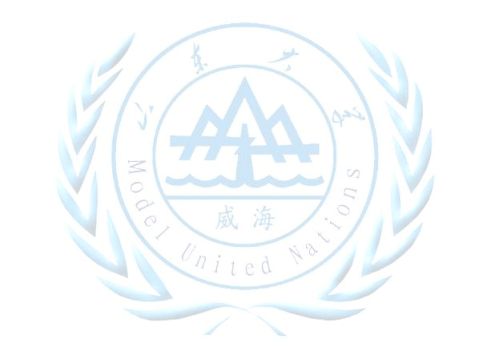
SDUW—MUN 2010.10
Meticulous flowchart:
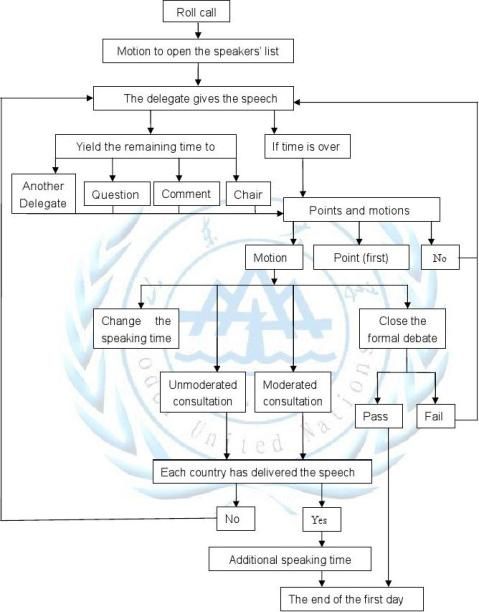
SICA - 19 -
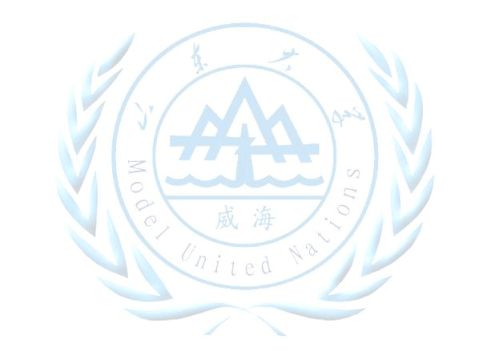
SDUW—MUN 2010.10
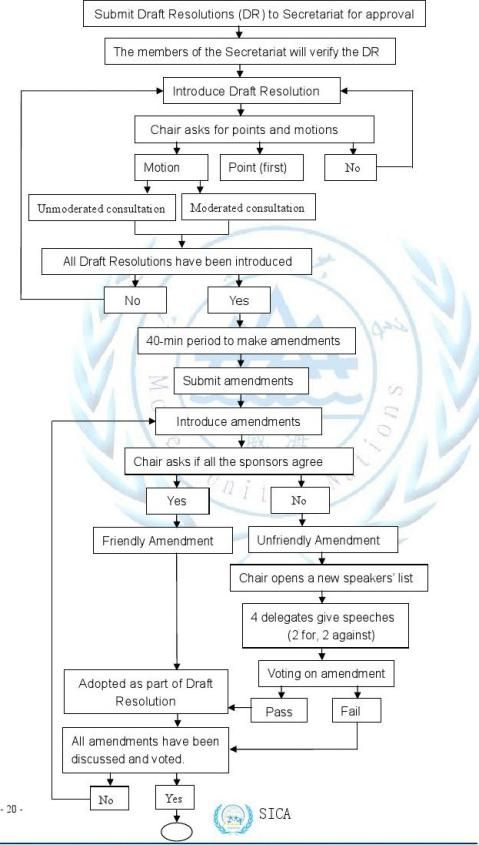
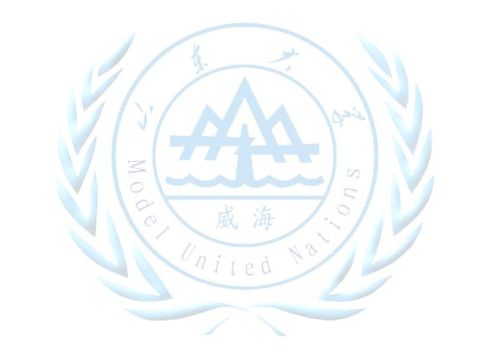
SDUW—MUN 2010.10
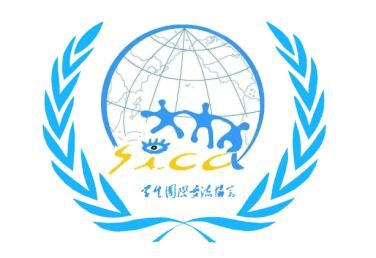
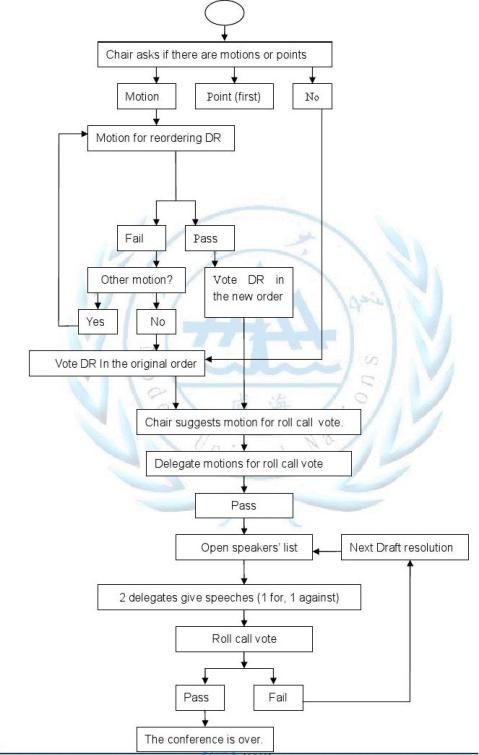
- 21 -
SDUW—MUN 2010.10
Fast rule flow index:
Motion for Caucus / Moderated Caucus Motion to Close the Speakers
List
Motion to Suspend the
Meeting
Simple
Motion requires purpose and time limit for caucus.
Majority Maximum time, including extensions, 15 minutes Simple
Same as Motion to Close the Debate
Either leads to informal debate (see Motion for
Majority Caucus/Moderated Caucus), or in order when the (50%+1)scheduled time of a committee session has elapsed. Simple
This motion will be in order after the closure of debate.
Motion to Reorder D.R.(s)
Majority Once it passes, the vote will follow the new order. Only (50%+1) one such motion can pass in the voting procedures. Two-minute introduction.
Only one Draft Resolution can be agreed.
Draft Resolution Amendment
Directly into the friendly amendment, as to the non-friendly
the amendment, you have one minute to introduce.
Yield
No multiple yields. May yield to 1) another delegate, 2) questions, 3) comments, 4) chair
Position Statement Aditional speaking Moderated Consultion
Time is limited to 120 seconds Time is limited to 90 seconds
The whole time is 3 minutes The time os each
delegate’s statement is 60 seconds.
(for reference)
Unmoderated Consultion 5 minutes 8minutes(for reference)
Non-friendly Amendment(Support & Against) Draft Resolution (Support & Against)
The time of delegate’s statement is limited to 60 seconds
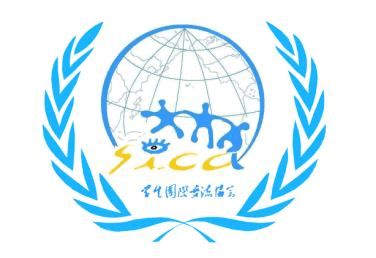
SDUW—MUN 2010.10
·Individual Award
Best Leadership Award One person
Best Eloquence Award One person
Best Talent Award One person
·Group Award
Best Position Paper Award Two group
Best Delegation Award Two group
Awards according to:
1)Representatives of the country show the real understanding of the national policy;
2)In formal and informal debate must pay attention to the etiquette;
3)To hold negotiations for the interests of the committee;
4) Have sufficient knowledge of the function of United Nations agencies;
5) Know the procedures and rules of the conference clearly;
6) Have the abilities to write some policies ,ideas and issues in committee .
SICA - 23 -
SDUW—MUN 2010.10
DRESS CODE
SDUWMUN will enforce a dress code for the delegates. We believe proper attire is important in preserving the atmosphere of our conference. “Semi-formal” or “Business” attire is the norm at the conference, so please use your best judgment in following this norm. The guidelines are as follows, and students will be expected to follow them, or will be asked to change before participating in committee. All faculty advisors and head delegates are urged to remind their delegates about the following guidelines so there will not be any problems. * Men should wear a suit or a jacket and dress pants (no jeans), with a dress shirt and tie.
* Women should wear a dress, suit, dress slacks or skirt, with a blouse or sweater (no jeans).
* Baseball caps and sneakers are not appropriate attire.
* Respectful use of non-Western professional attire is also appropriate at all committee sessions.
* Members of the committee staff and the Secretariat have the right to require a delegate to change before continuing participation at the conference at their discretion.
- 24 - SICA
SDUW—MUN 2010.10
(For reference only)
The financial crisis loosens the poorest countries already tenuous control over their economies. Many of them are financially incapable of boosting their economies, thus worsening the human rights situation. Their only options include turning to international aid organizations, for instance, World Bank and IMF to accelerate regional economic recovery or creating an environment conducive to the reduction of poverty and better facilitate access to education and health services through the adoption of principles of good governance.
More developed economies, however, have focused on monetary policy responses, which at least have been highly expansionary, counter-cyclical, bold and unprecedented in scope. Massive public funding was made available to recapitalize banks, including taking partial or full government ownership, as well as backing deposits and other assets with government guarantees and insurance.
However, these steps have not always ensured that banks make loans to stimulate the economy. There has also been little public analysis and dialogue about whether these massive bailout packages will come at the expense of social sector spending and the fulfillment of human rights in the future. USA
This global economic crisis had its origins in the U.S. financial markets. The U.S. government enacted a multi-billion dollar stimulus package in response to the economic downturn with the objectives of improving the employment situation and helping to cover some of the budget shortfalls state governments were facing. Although perhaps justified as an emergency response to the turmoil in the financial markets. From a human rights perspective, the impact of these policies is uncertain and should be subject to careful examination and constant monitoring and evaluation.
Given the immediacy and magnitude of the crisis, this may not have been the most effective or efficient way of creating stable jobs. Nevertheless, significant cutbacks to areas fundamental to the realization of social and economic rights have been made, particularly at the state level, since the onset of the economic crisis in the U.S.
SICA - 25 -
SDUW—MUN 2010.10
While tackling fiscal deficits may very well be of concern in the long term, the protection of people’s economic and social rights in the short-term through equitable, participatory, transparent and expansionary fiscal policy is essential to rebuilding and sustainable economic growth.
New Zealand
New Zealand included a provision in its stimulus package aimed at maintaining employment by creating more flexible working hours. However, as noted by one local human rights organization, flexible working hours disproportionately disadvantage low-income women who already suffer from a systemic pay gap, and who actually need more hours than higher paid men in order to make ends meet.
Caribbean Countries
In the relatively resource-poor Caribbean, governments have a good record of strengthening social spending and social protection in response to the crisis. For example, the government of Antigua and Barbuda subsidized utilities for pensioners and increased pension payments. Social welfare payments increased by 10% in Dominica and the minimum wage was increased. In St. Kitts and Nevis, the government distributed 224 acres of land to rural workers for agricultural production. In Grenada, a free milk program for families with small children and persons with special needs was instated. The government of Bolivia—one of the world‘s lowest income countries—raised the minimum wage 12% post-crisis, and spent more than 2% of its GDP investing in a number of social protection programs. These programs, transfers and bonuses helped to simultaneously offset the adverse impacts of the global downturn, bolster demand and economic activity, support particular disadvantaged groups (older persons, children, pregnant women and others) and help sustain people’s struggle out of poverty.
India: National Rural Employment Guarantee
India had in place various social protection measures before the downturn that softened the blow of the economic crisis. The 2005 National Rural Employment Guarantee Act (NREGA) is one example. Growing out of years of human rights advocacy and favorable legal rulings on the right to food, the NREGA guarantees adult members of any rural household one hundred days of employment every year to carry out public work at the statutory minimum wage. At least one-third of those employed must be women, and the Act provides for equal daily remuneration for women and men. Safe and adequate working conditions must also be ensured. Use of this employment-generation and wage-led recovery program has doubled since the economic crisis struck India. It serves as a powerful example of a human rights-centered economic policy in action, cushioning economic shocks by undergirding the enjoyment of one key economic and social right—the right to work—of many rural and migrating Indians.
- 26 - SICA
SDUW—MUN 2010.10
African Countries
The ongoing global financial crisis could potentially decrease global demand for basic commodities produced in Africa, private and public capital flow into Africa and the competitiveness of Member States’ economies. It has already exacerbated the poor enjoyment of social and economic rights In particular, food security by vulnerable and marginalized groups in Africa such as the poor, women, children, refugees and displaced persons, indigenous peoples, the disabled and people living with HIV/AIDS. It is also slowing down the progress of the United Nations Millennium Declaration (Millennium Development Goals). In response, the African Union has agreed to take steps to ensure implementation of national policies aimed at tackling the peculiar effects of the global financial crisis on their economies within the framework of realizing economic and social rights provided for and recognized by the African Charter, and to guarantee transparency and the participation of all relevant stakeholders in the process.
Continuously monitoring the impact of the global financial crises on vulnerable groups as mentioned above will strengthen efforts to eradicate corruption, mismanagement of financial resources and other similar vices in order to create the transparency and accountability necessary for economic growth and external investment. This in turn will create an environment conducive to the reduction of poverty and underdevelopment through the adoption of principles of good governance; and to intensify existing cooperation efforts between Member States through the harmonization of
macro-economic policies, acceleration of economic integration within regional economic communities and strengthening of financial regulatory mechanisms. Most importantly, they have agreed to ensure that the improvement in the enjoyment of economic and social rights by its citizens is central to any bilateral or multilateral trade and economic agreements.
SICA - 27 -
